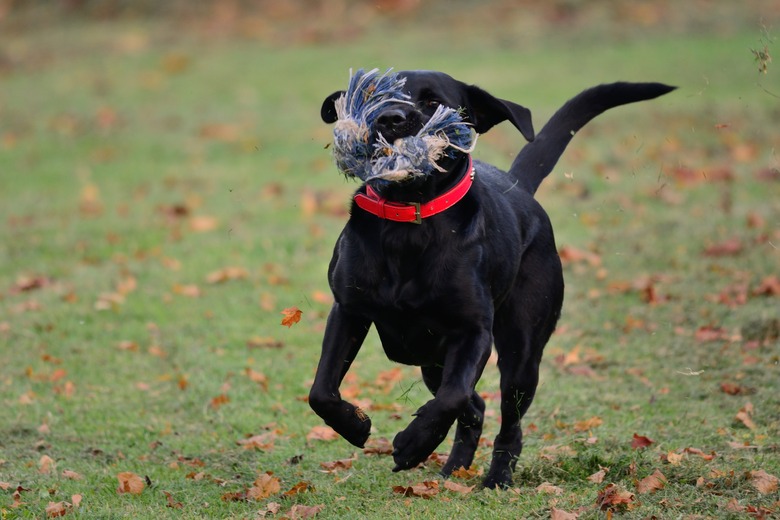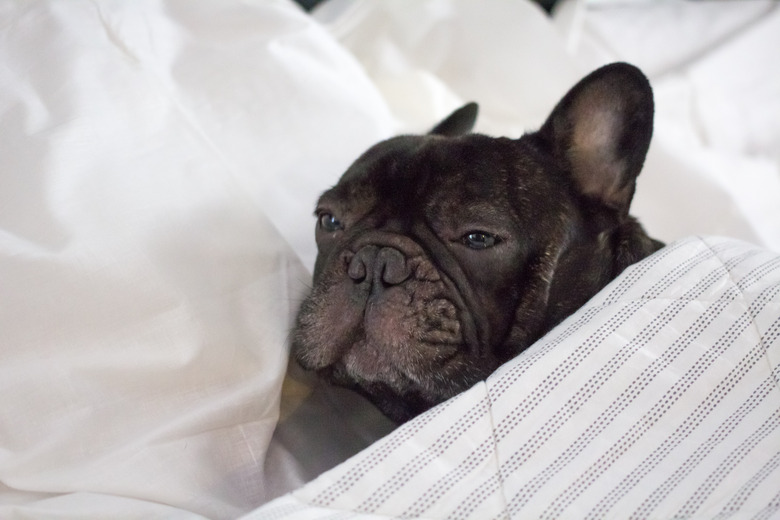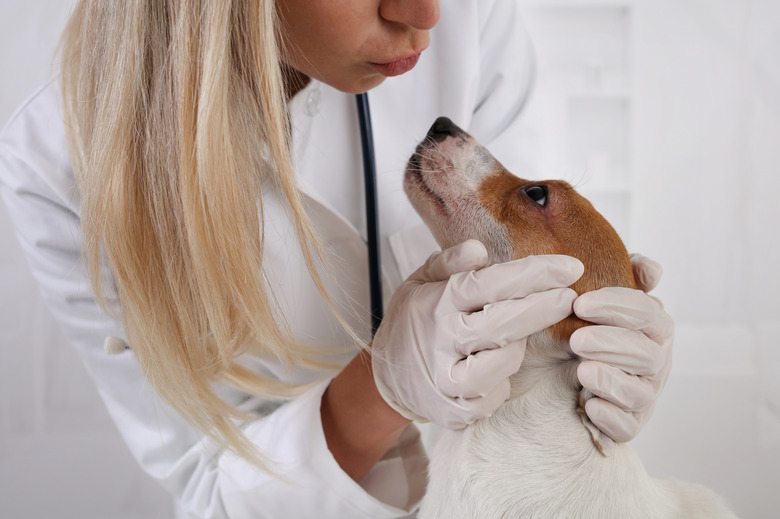What To Do If Your Dog Eats A Dead Animal
Somehow, dogs manage to simultaneously be some of the cutest creatures on the planet and some of the grossest. One minute, they're all, "Hi, hi, hi, hi I love you, you are the center of my universe, oh btw here is my belly please rub it now please" and the next they're like, "Cool! Cat poop! I'm going to put that in my mouth right now!"
And then you're like, "No! Don't eat the poop!" and your dog is like, "I don't understand most of those words, but I know 'no' and 'don't' and I can tell from your tone that you are mad at me, so here, have some kisses, that should make it better!" And the next thing you know, you're being kissed (cute) by a tongue that's just come in contact with feces (gross).
And that, my friends, is the dog's cute/gross paradox in a nutshell. We want to curb the gross behaviors for the obvious reasons, but what about when the gross crosses over into potentially dangerous too?
When it comes to gross-and-also-potentially-dangerous behaviors, eating dead things has to be near the top of the list. Here's what you need to do if your dog eats a dead animal and what you need to know about why they're so darn into doing it in the first place.
Why are dogs attracted to dead animals and other gross things?
Why are dogs attracted to dead animals and other gross things?
Like so many things with dogs, this all comes down to the smell. Dogs love stinky smells and dead things smell super gross (which, to a dog, is intriguing). Dead things also smell worse (which, to a dog, is better) the longer they've been dead, which means that waiting a few days won't make your dog less interested in the dead bird that's inexplicably on the sidewalk you take your walks on; he'll just get more and more interested as the days pass. Yay, right?
There are a few reasons dogs become obsessed with odors that make us humans gag. One popular theory traces things back to dogs' wolf ancestors, who would have very important survival reasons for hanging around gross stuff like dead animals and feces—the strong smells from these things can help cover the dog's (or wolf's) smell, which helps him hide from would-be predators.
We're also approaching this whole question from a very human standpoint. We've evolved very differently than dogs, so scents we've evolved to stay away from can actually smell good to dogs, who have evolutionary reasons to be attracted to those smells.
"Humans perceive 'bad' odors through either some inbuilt evolutionary acquired mechanism to prevent harm, e.g. repulsion by feces to prevent disease, or through learning," Peter Hepper, head of the school of psychology at Queen's University in Belfast, explained to Gizmodo.
Why do dogs want to put dead animals in their mouths?
Why do dogs want to put dead animals in their mouths?
This one is partially our fault, guys. Not "us" as dog owners specifically, but us as humans. These days, dogs are mostly just tasked with being our loyal companions, but many of the breeds we adore for their cuteness and kisses were bred to do very specific jobs, and many of those jobs included killing and retrieving dead animals.
If you have a hunting dog (think anything with the word "hound" in its name, but also dogs like beagles and dachshunds), then congratulations: You're living with a natural born killer. And if you love your lab or your Golden Retriever? The "retriever" part of their names is important—they have a natural instinct to pick up dead birds in their mouths and bring them back to you.
The good news here is that if your bred-to-be-a-working-dog pet walks up to you with a dead animal in her mouth, she might not be trying to eat it so much as do her innately trained job and bring it back to you as a present of sorts. So...yay?
Why do dogs use their nose and mouth to explore these gross things?
Why do dogs use their nose and mouth to explore these gross things?
While humans tend to take in the bulk of our information about the world through sight, dogs' primary sense is smell, which means sniffing is their way of learning about the world around them.
"So-called 'bad' and 'good' smells are products of our culture. As young children we are ambivalent toward smells like poo and stinky feet: we have to be taught that these are 'bad,'" Alexandra Horowitz, author Inside of a Dog and Being a Dog, explains. "Dogs, by contrast, are in but not of our culture. They do not inherit our value system (unless we explicitly train them in its rules) and so are left with their own canine tendencies....For dogs, there seem not to be good nor bad (with a few exceptions) smells; smells are just the way the world looks. Smells are just information."
Put simply: Your dog is curious. A strong odor is a wealth of information to a dog. Think of a dead animal or a pile of something smell like a fascinating book for your dog—even if it's one you want to put on your own personal Fahrenheit 451-style hit list.
Is playing with dead animals dangerous for dogs?
Is playing with dead animals dangerous for dogs?
Here's the good news: In most cases, playing with (sniffing, nosing, pawing, carrying, etc.) a dead animal isn't going to do your dog much real harm beyond making him unkissable to you for a while and maybe bumping bath time up by a few days.
There are, however, two things you have to worry about that could change that: If the dead animal in question was poisoned to death, that poison might also be toxic to your dog. Rat and mouse poisons are an especially common issue to look out for.
The other thing to worry about is the possibility that the animal in question is carrying a disease-causing bacteria that your dog could pick up. One of the most dangerous is clostridium botulinum—a type C preformed neurotoxin, which is sometimes found in dead animal carcasses (as well as in uncooked or spoiled foods—so keep your dog out of the trash) that causes botulism.
It's rare for dogs to contract botulism, but the effects can be serious. As the neurotoxin takes hold in your dog's body, it causes weakness throughout his body, starting in the back legs and then going forward to the torso, front legs, and neck and eventually leading to paralysis of all four limbs. In the most severe cases, the paralysis can impact the dog's ability to breathe, leading to death.
What should you do if your dog eats part of a dead animal?
What should you do if your dog eats part of a dead animal?
So, your dog ate part of a dead animal, huh? Time to dig into the "gross vs. dangerous" issue in a very real way.
The technical term for this behavior is "dietary indiscretion," which is just fancy vet talk for "dogs eat whatever they see even when that thing is not actual food." Dietary indiscretion can apply to any number of non-food things your dog might ingest, from dead animals and feces to toxic chemicals and a wide range of inanimate objects, from socks to tiny plastic pieces. Some acts of dietary indiscretion are more dangerous than others (if your dog has ingested a toxic chemical, head to the vet immediately), but all warrant some extra attention from you.
If your dog has eaten part of a dead animal, call your vet and tell them everything you know about the incident—what kind of animal was it? How long had it been dead? How much of it did you dog eat? Etc. From there, your vet might ask you to come in right away or they might recommend keeping an eye on your dog, looking out for signs that the dead thing in question is making your dog sick. These signs would include vomiting, diarrhea, lethargy, and loss of appetite.
One of the diseases dogs can pick up if they eat a dead animal is roundworm. This will often occur if a dog eats a mouse or rat that's infected with the parasite's larvae. These worms gobble up the nutrients in your dog's intestines, which can leave your pup malnourished even if he's eating a totally healthy diet. You'll have to see your vet for treatment if your dog picks up roundworm from any source. Signs of roundworm colic and coughing (which is a sign the roundworm larvae have made their way to the dog's lungs), lethargy, vomiting, abdominal swelling, abnormal feces, and loss of appetite.
Another parasite to look out for is coccidium, which dogs can contract by eating dead birds or rodents. Symptoms of coccidiosis include diarrhea (which, in severe cases, might contain blood or mucus), loss of appetite, dehydration, and vomiting.
The point: Talk to your vet right away if your dog has eaten a dead animal and be on the lookout for signs of distress in the weeks that follow the incident.
How to prevent your dog from eating dead animals:
How to prevent your dog from eating dead animals:
The best tool in your dog training arsenal when it comes to stopping your dog from eating dead animals (or trash or poop or anything else disgusting he finds on the ground when you're taking a walk) is the "leave it" command. You can teach leave it at home with treats (something you know your dog wants to put in his mouth).
Here's one way to train leave it (but you can find lots of tutorials online if this method isn't working for you or your dog):
Put a treat on the floor and when your dog approaches to sniff or eat it, cover the treat with your foot. The dog will probably still sniff and maybe even try to get to the treat, but stay strong and wait for him to give up. When he does (for this purpose "giving up" is defined as losing interest in the hidden treat and starting to walk away), click or say yes and reward him with a different treat.
Repeat this process until your dog associates the foot on the treat with leaving it alone and getting rewarded for doing so. At this point, start saying "leave it" when you cover the treat with your foot and continue rewarding when the dog loses interest. When he's mastered this, you can progress to dropping the treat on the floor and saying leave it to signal the desired disinterest. Once he's got it at home, practice on walks (and have treats handy to reward him when he leaves something you don't want him sniffing alone).
By teaching your dog "leave it," you'll (hopefully) never have to deal with your dog eagerly bringing you a dead animal and wondering why you don't seem excited about it.
Always check with your veterinarian before changing your pet's diet, medication, or physical activity routines. This information is not a substitute for a vet's opinion.


